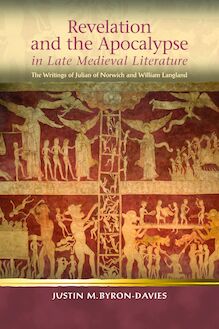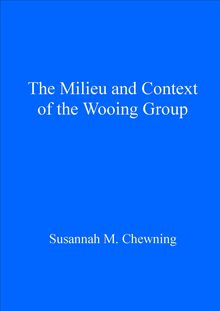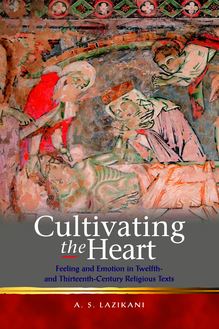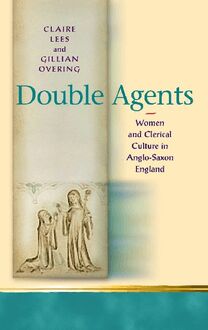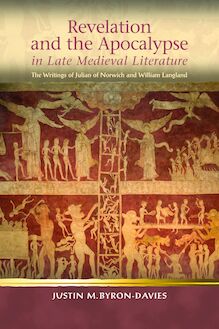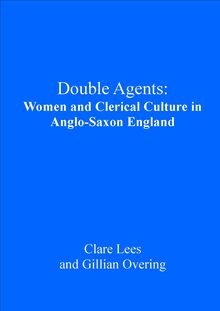Anchoritism in the Middle Ages , livre ebook
130
pages
English
Ebooks
2013
Vous pourrez modifier la taille du texte de cet ouvrage
Obtenez un accès à la bibliothèque pour le consulter en ligne En savoir plus
Découvre YouScribe et accède à tout notre catalogue !
Découvre YouScribe et accède à tout notre catalogue !
130
pages
English
Ebooks
2013
Vous pourrez modifier la taille du texte de cet ouvrage
Obtenez un accès à la bibliothèque pour le consulter en ligne En savoir plus
Publié par
Date de parution
30 avril 2013
Nombre de lectures
5
EAN13
9781783160396
Langue
English
Publié par
Date de parution
30 avril 2013
EAN13
9781783160396
Langue
English
RELIGION AND CULTURE IN THE MIDDLE AGES
Anchoritism in the Middle Ages
Series Editors Denis Renevey (University of Lausanne) Diane Watt (University of Surrey)
Editorial Board Miri Rubin (Queen Mary, University of London) Jean-Claude Schmitt (École des Hautes Études en Sciences Sociales, Paris) Fiona Somerset (Duke University) Christiania Whitehead (University of Warwick)
RELIGION AND CULTURE IN THE MIDDLE AGES
Anchoritism in the Middle Ages
TEXTS AND TRADITIONS
edited by
CATHERINE INNES-PARKER AND NAOË KUKITA YOSHIKAWA
© the Contributors, 2013
All rights reserved. No part of this book may be reproduced in any material form (including photocopying or storing it in any medium by electronic means and whether or not transiently or incidentally to some other use of this publication) without the written permission of the copyright owner. Applications for the copyright owner’s written permission to reproduce any part of this publication should be addressed to the University of Wales Press, 10 Columbus Walk, Brigantine Place, Cardiff CF10 4UP.
www.uwp.co.uk
British Library CIP Data A catalogue record for this book is available from the British Library.
ISBN 978-0-7083-2601-5 (hardback) 978-0-7083-2602-2 (paperback) e-ISBN 978-1-78316-040-2
The rights of the Contributors to be identified as authors of their contributions has been asserted by them in accordance with sections 77 and 79 of the Copyright, Designs and Patents Act 1988.
Typeset in Wales by Eira Fenn Gaunt, Cardiff Printed by CPI Antony Rowe, Chippenham, Wiltshire
C ONTENTS
Series Editors’ Preface
Acknowledgements
List of Illustrations
List of Abbreviations
Notes on Contributors
Introduction Catherine Innes-Parker and Naoë Kukita Yoshikawa
I TRADITIONS OF ANCHORITIC GUIDANCE
1 Can There Be Such a Thing as an ‘Anchoritic Rule’? Bella Millet
2 The Role of the Anchoritic Guidance Writer: Goscelin of St Bertin Mari Hughes-Edwards
3 Logical Discourse Markers in Julian of Norwich Fumiko Yoshikawa
II ENCLOSURE AND SANCTITY IN HAGIOGRAPHICAL TRADITION
4 Heresy and Heterodoxy: The Feminized Trinities of Marguerite Porete and Julian of Norwich Jane Chance
5 Hagiography and Idealism: St Dympna of Geel, an Uncanny Saint Juliana Dresvina
6 Bridal Mysticism and the Politics of the Anchorhold: Dorothy of Montau Sieglinde Hartmann
III ANCHORITIC TEXTS AND TRADITIONS IN THE LAY WORLD
7 Secularization in Ancrene Wisse, Part 1: The ‘Pater noster’, ‘Credo’ and ‘Ave’ Chiyoko Inosaki
8 Reading and Devotional Practice: The Wooing Group Prayers of British Library, MS Cotton Nero A.xiv Catherine Innes-Parker
9 Carmelite Spirituality and the Laity in Late Medieval England Naoë KukitaYoshikawa
10 Printing and Reading Walter Hilton in Early Tudor England Satoko Tokunaga
Bibliography
S ERIES E DITORS’ P REFACE
Religion and Culture in the Middle Ages aims to explore the interface between medieval religion and culture, with as broad an understanding of those terms as possible. It puts to the forefront studies which engage with works that significantly contributed to the shaping of medieval culture. However, it also gives attention to studies dealing with works that reflect and highlight aspects of medieval culture that have been neglected in the past by scholars of the medieval disciplines. For example, devotional works and the practice they infer illuminate our understanding of the medieval subject and its culture in remarkable ways, while studies of the material space designed and inhabited by medieval subjects yield new evidence on the period and the people who shaped it and lived in it. In the larger field of religion and culture, we also want to explore further the roles played by women as authors, readers and owners of books, thereby defining them more precisely as actors in the cultural field. The series as a whole investigates the European Middle Ages, from c .500 to c .1500. Our aim is to explore medieval religion and culture with the tools belonging to such disciplines as, among others, art history, philosophy, theology, history, musicology, the history of medicine, and literature. In particular, we would like to promote interdisciplinary studies, as we believe strongly that our modern understanding of the term applies fascinatingly well to a cultural period marked by a less tight confinement and categorization of its disciplines than the modern period. However, our only criterion is academic excellence, with the belief that the use of a large diversity of critical tools and theoretical approaches enables a deeper understanding of medieval culture. We want the series to reflect this diversity, as we believe that, as a collection of outstanding contributions, it offers a more subtle representation of a period that is marked by paradoxes and contradictions and which necessarily reflects diversity and difference, however difficult it may sometimes have proved for medieval culture to accept these notions.
A CKNOWLEDGEMENTS
We would like to thank the Social Sciences and Humanities Research Council of Canada and the Japan Society for the Promotion of Science for funding which made this project possible. Dylan Rose and Jennie Thompson were research assistants for this project and the book would have been longer in the making without their help. Our thanks also go to Dr Roger Ellis for his encouragement as we pursued this project.
Finally, we owe thanks to Sarah Lewis and Siân Chapman of the University of Wales Press for their unfailing support, and the contributors for entrusting us with editing and proofreading. Any shortcomings are our responsibility.
Catherine Innes-Parker and Naoë KukitaYoshikawa
I LLUSTRATIONS
Plate 1 Jan van Wavere (?), St Dympna altarpiece, c .1515 (made in Mechelen/Brussels for the Church of St Dympna, Geel). Image courtesy of Royal Institute for Cultural Heritage, Brussels, © KIK-IRPA, Brussels.
Plate 2 St Dympna, modelled on the iconography of St Margaret and St Juliana, Dutch, nineteenth century, Geel. Image courtesy of Royal Institute for Cultural Heritage, Brussels, © KIK-IRPA, Brussels.
Plate 3 St Margaret Altar: north German limewood altarpiece, carved and painted, early sixteenth century, Victoria and Albert Museum (192-1866), panels 1–4. Photo: Juliana Dresvina.
Plate 4 Memorial brass of Henric van Tongheren (died in 1448), Geel, showing The Virgin with the Child, flanked by St Catherine and St Dympna instead of the more conventional St Margaret. Image courtesy of Royal Institute for Cultural Heritage, Brussels, © KIK-IRPA, Brussels.
Plate 5 The Holy Kindred and the Trinity Triptych: St Dimpna and St Margaret (Köln, Wallraf-Richartz-Museum). Photo: © Rheinisches Bildarchiv, Marion Mennicken, rba_c018916
Plate 6 Walter Hilton, The Scale of Perfection (London: Wynkyn de Worde, 1519), STC 14043.5. St Mary’s College, Oscott, RF7 [R00559], sig. B4 r . Trustees of St Mary’s College, Oscott.
Plate 7 The Kalendre of the New Legende of Englande (London: Richard Pynson, 1516), STC 4602, sig. y4 v . The British Library, 205.c.19. © The British Library Board.
A BBREVIATIONS
AASS Acta Sanctorum BMC XI: Hellinga, Lotte (ed.), The Catalogue of Books Printed in the XVth Century Now in the British Library, XI: England (‘t Goy-Houten: Hes de Graff, 2007). CCCM Corpus Christianorum: continuatio medieualis (Turnhout, 1966). CCSL Corpus Christianorum: series latina (Turnhout, 1953). CSEL Corpus scriptorum ecclesiasticorum latinorum (Vienna, 1866). EETS Early English Text Society. ES Extra Series ESTC English Short Title Catalogue, http://estc.bl.uk/ . OS Original Series PL J.-P. Migne (ed.), Patrologiae cursus completus … Series Latina (Paris, 1844–65)
N OTES ON C ONTRIBUTORS
Jane Chance , Andrew W. Mellon Distinguished Professor Emerita in English at Rice University, has taught and published on medieval literature and medievalism for fortyone years. A recipient of NEH and Guggenheim fellowships and membership in the Institute for Advanced Study-Princeton, she has published twenty-two books, edited three book series (including the Library of Medieval Women) and served on the Advisory Committee of PMLA. Her most recent monograph, The Literary Subversions of Medieval Women , New Middle Ages Series (New York: Palgrave Macmillan, 2007), was awarded the SCMLA Prize. She has also published Woman as Hero in Old English Literature (Syracuse, NY: Syracuse University Press, 1986) and edited Women Medievalists and the Academy (Madison: University of Wisconsin Press, 2005).
Juliana Dresvina is a British Academy postdoctoral fellow at King’s College London and a research member of Wolfson College, Oxford, working on the psycho-history of late medieval mysticism. Her other research interests include manuscript production; hagiography, its transmission and reception; expressions of medieval piety; and medievalism. Apart from several articles on the cult of St Margaret, she published an edition of Julian of Norwich’s writings with the first ever Russian translation in Moscow in 2010, and is a co-editor, with Nicholas Sparks, of two volumes: The Medieval Chronicle VII (Rodopi: Amsterdam and New York, 2011) and Authority and Gender in Medieval and Renaissance Chronicles (Newcastle: Cambridge Scholars Publishers, 2012).
Sieglinde Hartmann is Professor of medieval German literature at the University of Würzburg, Germany and holds lectureships at the universities of Paris (Sorbonne), Graz (Austria) and Baku (Azerbaijan). She is a member of the Programming Committee of the International Medieval Congress, University of Leeds, responsible for German and comparative literature; president of the Oswald von Wolkenstein-Gesellschaft, and editor-in-chief of the Jahrbuch der Oswald von Wolkenstein Gesellschaft . She has published on German, French, Spanish and Italian literature of the Middle Ages, with a special focus on Oswald von Wolkenstein and the late Middle Ages.
Mari Hughes-Edward
